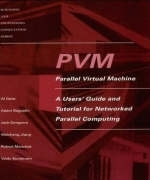
PVM
MIT Press (Verlag)
978-0-262-57108-1 (ISBN)
- Keine Verlagsinformationen verfügbar
- Artikel merken
Written by the team that developed the software, this tutorial is the definitive resource for scientists, engineers, and other computer users who want to use PVM to increase the flexibility and power of their high-performance computing resources. PVM introduces distributed computing, discusses where and how to get the PVM software, provides an overview of PVM and a tutorial on setting up and running existing programs, and introduces basic programming techniques including putting PVM in existing code. There are program examples and details on how PVM works on UNIX and multiprocessor systems, along with advanced topics (portability, debugging, improving performance) and troubleshooting.
PVM (Parallel Virtual Machine) is a software package that enables the computer user to define a networked heterogeneous collection of serial, parallel, and vector computers to function as one large computer. It can be used as stand-alone software or as a foundation for other heterogeneous network software. PVM may be configured to contain various machine architectures, including sequential processors, vector processors, and multicomputers, and it can be ported to new computer architectures that may emerge.
William Gropp is Director of the Parallel Computing Institute and Thomas M. Siebel Chair in Computer Science at the University of Illinois Urbana-Champaign. Ewing Lusk is Argonne Distinguished Fellow Emeritus at Argonne National Laboratory.
Part 1 Introduction: heterogeneous network computing; trends in distributed computing; PVM overview; other packages. Part 2 The PVM system. Part 3 Using PVM: how to obtain the PVM software; setup to use PVM; setup summary; starting PVM; common startup problems; running PVM programs; PVM console details; host file options. Part 4 Basic programming techniques: common parallel programming paradigms; workload allocation; porting existing applications to PVM. Part 5 PVM user interface: process control; information; dynamic configuration; signalling; setting and getting options; message passing; dynamic process groups. Part 6 Program examples: fork-join; dot product; failure; matrix multiply; one-dimensional heat equation. Part 7 How PVM works: components; messages; PVM daemon; libpvm library; protocols; message routing; task environment; console program; resource limitations; multiprocessor systems. Part 8 Advanced topics: XPVM; porting PVM to new architectures. Part 9 Troubleshooting: geting PVM installed; getting PVM running; compiling applications; running applications; debugging and tracing; debugging the system. Appendices: history of PVM versions; PVM 3 routines.
| Reihe/Serie | Scientific and Engineering Computation |
|---|---|
| Verlagsort | Cambridge, Mass. |
| Sprache | englisch |
| Maße | 198 x 226 mm |
| Gewicht | 544 g |
| Themenwelt | Mathematik / Informatik ► Informatik ► Betriebssysteme / Server |
| Informatik ► Office Programme ► Outlook | |
| Mathematik / Informatik ► Informatik ► Theorie / Studium | |
| ISBN-10 | 0-262-57108-0 / 0262571080 |
| ISBN-13 | 978-0-262-57108-1 / 9780262571081 |
| Zustand | Neuware |
| Haben Sie eine Frage zum Produkt? |
aus dem Bereich


